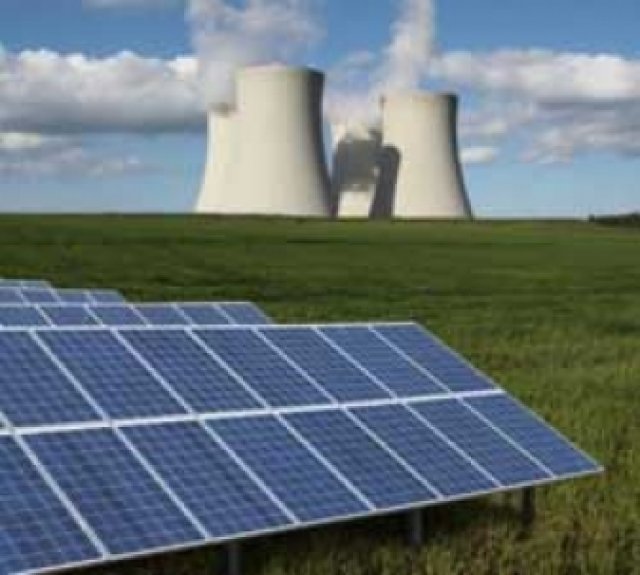
Nuclear fission is an innately dangerous process – and the nuclear industry’s record of handling the dangers has been well short of perfect. Traditionally, that’s been enough for the environment movement to reject nuclear energy.
Climate change, though, subjects this established position to an important challenge. The final death toll from the Chernobyl nuclear disaster, by some estimates, could reach hundreds of thousands. But a full-scale climate disaster could kill most of humanity − thousands of millions of people.
Does this mean that a massive roll-out of nuclear plants is essential to help end greenhouse gas emissions? Pro-nuclear activists argue that it is.
None of us should dismiss these arguments without careful thought – the climate danger is too great. But the nuclear advocates, too, have to prove their case. Does their reasoning hold up?
Humanity’s carbon budget
Humanity is on a tight carbon emissions “budget”. Scientists tell us that if we exceed a strictly limited cumulative tonnage of greenhouse emissions between the years 2000 and 2050 then “extremely dangerous” warming soon becomes inevitable.
In practice, massive cuts need to start almost immediately. Delay them only a few years, and the speed of the cuts required later on will be far greater − even impossible without shutting down modern civilisation.
In a much-cited paper from 2008, British climate scientists Kevin Anderson and Alice Bows construct various scenarios of how emissions might peak and then decline, with atmospheric carbon stabilising at different levels.
Their first scenario tracks the path to an eventual level of atmospheric greenhouse gases (expressed as carbon dioxide equivalent, or CO2e) of 450 parts per million by volume (ppmv). This is not much higher than today’s level.
To hold greenhouse gases to 450 ppmv CO2e, Anderson and Bows calculate, global emissions would need to peak in 2015, then quickly begin a sustained fall at annual rates of at least 4% a year. In the past, such declines have been seen only briefly during the early “slump” phase of severe economic crises. The fall would need to continue at this rate for decades.
If the emissions peak doesn’t occur until 2020, the position gets dramatically more difficult. Stabilising greenhouse gases at 550 ppmv CO2e (corresponding to an average temperature rise of about 3ºC) would then require energy and process emissions to fall, and keep falling, at an annual rate of 9%. That’s approaching twice the maximum rate during the collapse of the Russian economy in the 1990s.
If emissions peaked in 2020, and the annual rate of decline of energy and process emissions thereafter was a less rapid 3.5%, atmospheric greenhouse gases would finish up at around 650 ppmv
CO2e.
This level corresponds to a rise in average global temperatures later in the century of about 4ºC.
Anderson spelt out the implications of this rise in a 2009 interview: “I think it’s extremely unlikely that we wouldn’t have mass death at 4ºC. If you’ve got a population of nine billion by 2050 and you hit 4ºC, 5ºC or 6ºC, you might have half a billion people surviving.”
Plainly, humanity and nature are in appalling trouble. But is nuclear power the solution?
The nuclear non-option
Nuclear plants are not quick to build. And remember, for a bearable outcome global emissions have to start falling steeply well before 2020 — if possible, soon after 2015.
Let’s take a best-practice scenario for building nuclear plants. Planning, site selection and approval would take 1 to 2 years, followed by construction over 4 to 5 years. That suggests that the first big impacts of an all-out program of nuclear construction would start to be felt in 2017-18, with emissions peaking perhaps a year later.
That’s too late. We’d be at extreme risk of climate disaster.
Moreover, that’s the ideal scenario. In practice, the build-out would take much longer. Bravenewclimate.com's Barry Brook speaks of the need for a sustained, 25-fold expansion of nuclear construction over recent levels. Most of this would have to occur in countries with no direct experience of nuclear engineering. And where would the highly trained, experienced nuclear engineers and technicians come from at short notice?
Emissions wouldn’t start falling until well after 2020 — effectively guaranteeing catastrophe.
The renewables challenge
If nuclear plants can’t be built at the rate needed, does that spell doom for most of humanity? Fortunately, no. The numbers for renewable energy are immensely challenging, but unlike those for nuclear, not prohibitive.
Large wind farms can be operating as soon as three months after the start of construction. Build times for concentrating solar thermal plants with molten-salt storage — needed to provide base-load power — are longer, but off-site fabrication of standardised mirrors should cut these times to under a year.
Granted, the amounts of steel and concrete needed for renewable energy are much greater than for nuclear. Brook provides the figures. But using his data, it’s not hard to show that the amounts needed could readily be supplied out of the existing unused capacity of the world steel and cement industries.
What about the need for engineers and technicians? People would have to be taken from other technical pursuits and swiftly retrained. But unlike the case with nuclear power, the skills involved are fairly generic.
Meanwhile, if a wind turbine is built and installed wrongly, it won’t force the evacuation of a whole region.
Preventing climate catastrophe is a huge task. The only meaningful historical parallel is with the vast mobilisation of industrial and human resources undertaken to fight World War II.
That mobilisation took place, and the war was won. Forestalling climate disaster is possible too. Only, it can’t be done through relying on nuclear energy.
Comments
Anonymous replied on Permalink
Anonymous replied on Permalink